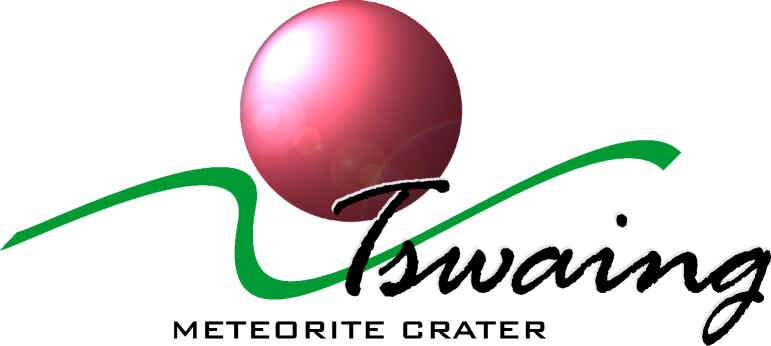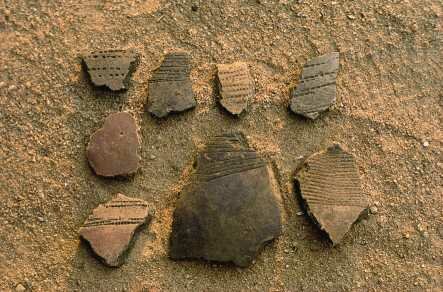|
800-year old Iron Age potsherds found near the crater lake (courtesy National Cultural History Museum) |
 |
|
People At Tswaing |
|
| Stone Age people It is quite possible that the meteorite impact event was actually seen by humans, as the Magaliesberg and, in particular, the Wonderboompoort area south of Tswaing, had been periodically inhabited by Early Stone Age people since 500 000 years ago. However, none of the typically large and rather crude tools made at Wonderboom have yet been found at Tswaing. While there were many inhabited sites along the Magaliesberg, there probably was no need to visit Tswaing where animal and plant life only slowly re-established itself after the impact. Regular visits by people only began during Middle Stone Age times, about 150 000 to 30 000 years ago. Small nomadic groups came to Tswaing from time to time to hunt, gather edible and medicinal plants and to collect salt. They made tools and weapons of bone, stone and wood, although smaller and in greater variety then their Early Stone Age predecessors. Many scrapers, point and other stone tools that were thrown away or lost have been found at Tswaing. These objects were probably brought from elsewhere, because the Tswaing rocks are not suitable for the making of stone artefacts. At Tswaing a few stone artefacts from the Late Stone Age have been found, brought there by the ancestors of the San (Bushman) people, who lived from 30 000 to 2 000 years ago. Iron Age communities The first farmers using iron implements, ancestors of the present indigenous peoples, came to South Africa about 1 750 years ago. The migration by Iron Age communities towards the South African highveld (on which Tswaing is located) only took place in more recent times, about 800 to 900 years ago. It was during this period, the Late Iron Age, when the first Iron Age communities came to Tswaing. Shards from decorated clay vessels, found on the crater floor, indicate that they were early Sotho- or Tswana-speaking communities, also known as the Moloko. Similar pot fragments have been found in the Waterberg mountain range, about 60 kilometres north of Tswaing. The remains, consisting of only a few stone walls at an old surveyor's beacon on the north-western crater rim, on one small Iron Age settlement have been found at Tswaing. Broken grindstones and potshards, both decorated and undecorated, have been observed here. It is possible that the Iron Age groups who did come to the crater were periodical visitors from the Waterberg region, whose main purpose was to collect salt. It was used for flavouring and preserving food as well as for trading. The decorated pottery made way for undecorated clay utensils and the large number of undecorated potshards found in the crater indicate frequent visits by Sotho- or Tswana-speaking Iron Age groups in more recent times, until the coming of the Matebele in the 1820s. Drought, famine and competition for natural resources triggered tremendous upheavals among many Iron Age societies in southern Africa in the early 19th century. This resulted in new political groupings, growth of militarism and the emergence of new dominant kingdoms. One of these was the Matebele Empire, established north of the Vaal River in the early 1820s, when a band of Nguni-speaking refugees, under the leadership of Mzilikazi from KwaZulu-Natal began attacking and conquering Sotho tribes. Although no proof has been found yet, it is possible that the Matebele visited Tswaing to collect salt and hunt the many wild animals that roamed here. Colonial settlers Soon after the departure of the Matebele in the early 1830s, the Tswaing area was claimed by another new group of settlers, the Voortrekkers. They were white Boer farmers, who had emigrated from the Eastern Cape region to KwaZulu-Natal and the interior. The Voortrekkers regarded the land that had been occupied and abandoned by the Matebele, whom they eventually defeated in 1837, as land available for permanent colonial settlement. In the 1850s Boer farmers began dividing the region north of the Magaliesberg into huge farms. The crater became the centre of one such farm, aptly named Zoutpan (Dutch for Salt Pan). During the 1890s, when Zoutpan was surveyed properly for the first time, its northeastern quarter became a separate farm, named Uitspan (Outspan, or resting-place). During the 19th century, Tswaing, and also the Soutpansberg saltpan, were the chief sources of natural salt for the region north of Pretoria, which was established in 1855 as the capital of the Transvaal Boer Republic. Because of its economic importance, Zoutpan became state property in 1876. For the greater part of the 19th century, Tswaing remained the most important salt-lick north of Pretoria and, as such, the gathering-place of great herds of game until these were scared away by early mechanised salt-mining operations. Their numbers were further decimated by hunting and the rinderpest epidemic of 1896-1897. Numerous bullets are still found in the soft mud on the crater floor, indicating that Tswaing was a hunting-ground until the late 1870s. By that time primitive mechanised salt-extraction had been established as the main economic activity. |
|
| (Source: REIMOLD, W U, BRANDT, D, DE JONG, R C, HANCOX, J, 1999, Tswaing Meteorite Crater. An introduction to the natural and cultural history of the Tswaing region including a description of the hiking trail. Popular Geoscience Series 1. Pretoria: Council for Geoscience. Available at the Council for Geoscience, Pretoria, South Africa) | |
| All intellectual property rights, including but not limited to copyright and trademarks, vested in the material contained on the NFI website is held by the NFI and may not be copied, reproduced, adapted, published or distributed in any form whatsoever without the prior written consent of the responsible person at the NFI. | |
